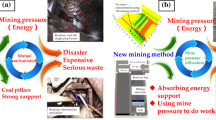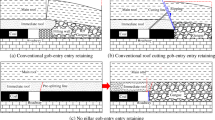Abstract
This study uses theoretical analysis, finite difference numerical simulations with FLAC3D software, and a field test to determine and demonstrate the most reasonable width for a retained gob-side entry and the most reasonable dimensions for filling bodies to support that entry under soft and fractured rock. The paper proposes a set of technical measures to maintain the retained roadway. These measures are a combination of: (1) enhancing the strength of the rock surrounding the roadway with coupled bolt–mesh–anchor supports during excavation; (2) reinforcing the roof support in the backfilled area with bolts and wire mesh before the gob-side entry is re-entered; and (3) using single hydraulic props followed by concrete and gangue as roadside backfill to support the gob-side entry roadway. For the particular case considered in this study, a field trial at the 1702 face in the Zhaoguan Coal Mine, China, has verified that the proposed measures are effective. The field test results indicate that deformation around the retained roadway driven under soft and fractured rock has been effectively controlled. The maximum roof to floor convergence was no more than 450 mm and the lateral deformation of the roadway’s sides was less than 300 mm, much less than the deformation at the unreinforced 1704 face in the same mine.









Similar content being viewed by others
References
Cao SG, Chen XZ, Yang HY et al (2016) Analysis on roadside control technology of gob-side entry retaining and applicable conditions. Coal Sci Technol 44(4):27–33
Chang Q, Tang W, Ying X et al (2018) Research on the width of filling body in gob-side entry retaining with high-water materials. Int J Rock Mech Min Sci 28:519–524
Chen Y, Bai JB, Zhu TL et al (2012) Mechanisms of roadside support in gob-side entry retaining and its application. Rock Soil Mech 33(5):1427–1432
Gong P, Ma Z, Zhang RR (2017) Surrounding rock deformation mechanism and control technology for gob-side entry retaining with fully mechanized gangue backfilling mining: a case study. Shock Vib. https://doi.org/10.1155/2017/6085941
Guo ZP, Mou WQ, Huang WP et al (2015) Analysis on roadside support method with constant resistance yielding-supporting along the goaf under hard rocks. Geotech Geol Eng 34:827–834
Han CL, Zhang N, Wang XQ et al (2013) Bearing behavior of block wall structure in gob-side entry retaining and its application. J Min Saf Eng 30(5):673–678
He M, Gao Y, Yang J et al (2017) An innovative approach for gob-side entry retaining in thick coal seam longwall mining. Energies 10(11):1785
Hua X (2006) Development status and improved proposals on gob-side entry retaining support technology in China. Coal Sci Technol 34(12):78–81
Kang HP, Niu DL, Zhang Z et al (2010) Deformation characteristics of surrounding rock and supporting technology of gob-side entry retaining in deep coal mine. Chin J Rock Mech Eng 29(10):1977–1987
Li YF, Hua XZ (2012) Mechanical analysis of stability of key blocks of overlying strata for gob-side entry retaining and calculating width of roadside backfill. Rock Soil Mech 33(4):1134–1140
Liu K (2013) Rib control technology of gob-side entry retaining in high stress soft rock roadway. Coal Sci Technol 41(10):38–41
Ma Q, Tan Y, Zhao Z et al (2018) Roadside support schemes numerical simulation and field monitoring of gob-side entry retaining in soft floor and hard roof. Arab J Geosci 11:563
Sun CD, Zhang DS, Wang XF et al (2012) Large-size test on creep characteristics of high water material for filling body beside roadway. J Min Saf Eng 29(4):487–491
Tan YL, Yu FH, Ning JG et al (2015) Design and construction of entry retaining wall along a gob side under hard roof stratum. Int J Rock Mech Min Sci 77:115–121
Tan YL, Yu FH, Ning JG et al (2016) Adaptability theory of roadside support in gob-side entry retaining and its supporting design. J China Coal Soc 41(2):376–382
Wang XC (2014) Study on gob-side entry retaining without filling in soft rock roadway. Hydraul Coal Min Pipeline Transp 1(3):30–31
Yang HY, Cao SG, Li Y et al (2015) Soft roof failure mechanism and supporting method for gob-side entry retaining. Minerals 5(4):707–722
Zhang JX, Jiang HQ, Miao XX et al (2013) The rational width of the support body of gob-side entry in fully mechanized backfill mining. J Min Saf Eng 30(2):159–164
Zhang N, Han CL, Kan JG et al (2014) Theory and practice of surrounding rock control for pillarless gob-side entry retaining. J China Coal Soc 39(8):1635–1641
Acknowledgements
This study was supported by Project of National Natural Science Foundation of China (51574156).
Author information
Authors and Affiliations
Corresponding author
Rights and permissions
About this article
Cite this article
Deng, L., Lv, J. & Chen, Y. Supporting a Retained Gob-Side Entry Under Soft and Fractured Rock: Computer Simulations and a Practical Example. Geotech Geol Eng 37, 2283–2292 (2019). https://doi.org/10.1007/s10706-018-0745-y
Received:
Accepted:
Published:
Issue Date:
DOI: https://doi.org/10.1007/s10706-018-0745-y




